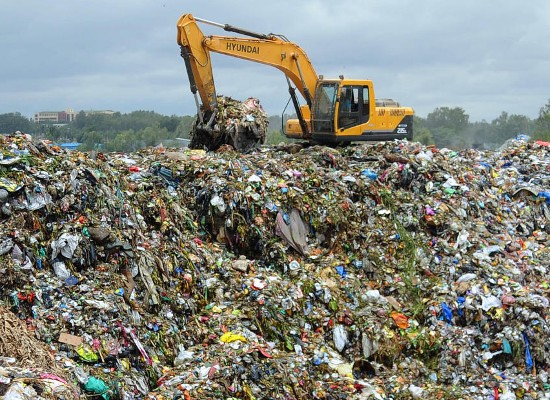When we fill garbage dumps in the Developed World with the waste from our consumer-oriented economies and bury it, we are creating a problem for future generations. Why? Because landfills are a significant environmental challenge. What’s in them can eventually contaminate the immediate areas around them, and groundwater resources lying under them.
For a city like Toronto where I live, the municipality collects, transports, processes, and disposes of more than 900,000 tons of waste annually. Not all goes into landfills, but what does end up being dumped and buried is transported more than three hours away to a site over 200 kilometres (124 miles) away. The site includes environmental enhancements that capture what leaches out in terms of liquids and gas. Upgraded stormwater drainage and monitoring of the state of underlying groundwater are in place, as are pipes for collecting and flaring produced gasses. In addition, the city has organic and solids recycling and recovery facilities. In 2020, the city claimed over 413,000 tons being diverted through its residential and commercial green and blue bin programs. What it didn’t report was the level of contamination within these diversion streams that ultimately lead to the diverted waste having to be carted to the landfill site. Nor does the city account for the carbon emissions contribution of trucking its waste 200 kilometres daily.
What if we were to change from the paradigm described above to one where the energy contained in the waste serves to generate electricity and heat while not contributing greenhouse gas emissions to the atmosphere. Methane and carbon dioxide would be captured from the flue gas stream while the remains of the incineration process, mostly ash, would go through further recovery to harvest usable metals and materials for infrastructure builds such as roads. construction. This is the very definition of a circular solution that is environmentally sustainable, and socially responsible.
If we are prepared to integrate carbon capture and sequestration into thermal-power generation that uses coal, and natural gas, why aren’t we talking about doing this for waste?
Vancouver-based, EnviroLab is involving young people between ages 18 and 30 in a number of labs focused on urban sustainability challenges and seeking zero-emission solutions. The goal is to design waste out of the way we live our lives by applying circular economic principles and practices. The EnviroLab website talks about the linear nature of current economic models and asks its participants to “recognize the cyclical potential” of the stuff we create and use every day. Questions posed include:
- What behavioural shifts can we encourage within zero waste initiatives to create a lasting impact on the circular economy model?
- What opportunities are there for environmental, economic and social interventions when thinking about zero waste?
- How can youth voice their concerns and meaningfully engage local governments to innovate?
- What opportunities exist leveraging zero waste initiatives that support environmental sustainability while creating employment for youth and future generations?
- Who is missing from a conversation about zero waste?
A number of new programs arising from the lab included:
- An initiative to work with construction companies on a business case for “designing for deconstruction.”
- Developing restaurant ecosystems so that viable food is collected and redistributed rather than ending up in landfills or organic recycling diversion programs. (See the program instituted by the City of Milan, Italy, a recent winner of the Earthshot Prize).
- Working with local farm suppliers to minimize organic waste.
- Educating homeowners and developers about implementing circular construction practices for new builds and retrofits.
- A novel reusable pill bottle program to divert used prescription bottles from landfills.
- And using mealworms to break down soft plastics and styrofoam.
These are all important initiatives. But what appears to have never been discussed is the incineration of waste. The imagery of burning garbage just doesn’t fit with environmentally aware young people and activists in the green movement. And yet we have the technology to implement net-zero waste-to-energy solutions allowing us to address electricity and heating demands and the 100% reuse of residual solids.
We shouldn’t be ignoring waste-to-net-zero-energy. It should be part of the conversation. Why? Because it will eliminate legacy and future landfills, and it will turn waste into an energy resource we can manage responsibly. Waste-to-net-zero-energy is one more solution in our effort to mitigate global warming.
















